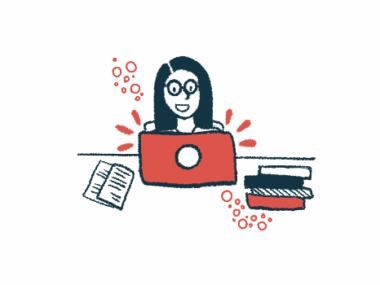A spine MRI for ankylosing spondylitis: A patient’s perspective
Fifty minutes is a long time to do nothing but lie there
Written by |

I recently had to get a full spine MRI to check the progression of my ankylosing spondylitis (AS). It didn’t hurt in the slightest, but I found it to be an intense sensory experience.
Many AS patients get an MRI as part of their diagnosis. It’s a safe and noninvasive way to evaluate the spine and joints that might be affected by AS, including the sacroiliac joints.
I knew the procedure would be painless, but I still felt slightly nervous on the drive to the radiology clinic. An MRI involves lying still inside a machine, which is described at Radiologyinfo.org as “a large cylinder-shaped tube surrounded by a circular magnet.” I wouldn’t call myself claustrophobic, but I don’t exactly enjoy being confined in small spaces.
I had to change into a hospital gown, which was surprisingly comfortable. I also had to remove any metal objects, including all jewelry. Luckily, I’d already removed my tight wedding ring at home with the help of some baby oil to ease it over my finger joint.
The radiology assistant and specialist showed me the MRI machine, which looked like a huge glossy white tube that filled half the room. I was helped to lie down on the narrow scanning bed that would slide into the machine. I was also handed a pair of foam earplugs and then a big set of earmuffs, through which to listen to music, which I hoped would make the 50-minute spinal scan go faster.
Lastly, I was given a long cord with a bulb-like button on the end, which I was to hold and could press if I felt uncomfortable or needed to stop the scan. I gripped the cord tightly as I was rolled smoothly into the MRI tube. Through my headphones I could hear the soothing voice of the radiologist, telling me everything looked great and the scan was about to start.
Lying completely still on my back, I shut my eyes as fans pushed cool, fresh air over my body. I tried to relax, knowing all I had to do was entertain myself inside my head for the next 50 minutes.
Noise, noise, noise — and sensory deprivation
I was able to hear an incredible range of noises from inside the MRI machine. The sound is described by Cedars Sinai Hospital as “intermittent humming, thumping, clicking and knocking sounds.” I laughed when I read this description later because I found them to be insanely loud, not humming. Even with two layers of ear protection, I felt like I was underneath a building demolition site.
Each hammering or intense whirring noise seemed to reverberate in my brain, making it impossible to hear more than a few seconds of music. A nap was out of the question, with the loud cacophony resonating through my whole body. It was like listening to the world’s loudest music concert as played by robots. Lying by yourself inside a machine without being able to hear or see anything going on around you is quite a surreal experience. It reminded me of the old-fashioned tanning beds, where you’d lie back and pull a lid over yourself, bathed in bright light.
Fifty minutes doesn’t sound like a long time to lie still, but when you have zero sensory input it seems like an eternity. I started by trying to plan my next art exhibition in my head, but the intense noises made it difficult to think.
To keep my mind occupied, I tried to entertain myself. Each different MRI noise became a set of words repeated over and over. A two-note resonant hammering scan became Starsky from “Starsky & Hutch“ saying “Do it. Dooooo it.” I pictured Ben Stiller’s comical face and accent, and it made me giggle.
About 35 minutes into the MRI, I started feeling panicky as the heat was building and my heart started pounding. I tried to calm myself, but ended up pressing the button and slid immediately out of the tube. The radiology team were wonderfully calming, helped me cool down and relax, and I managed to get through the rest of the scan without issues.
An MRI is nothing to worry about overall, I think. The worst part for me was the noise and sensory deprivation. I’ve heard some MRI machines have more space around the patients, which I think would help with feeling claustrophobic.
Note: Ankylosing Spondylitis News is strictly a news and information website about the disease. It does not provide medical advice, diagnosis, or treatment. This content is not intended to be a substitute for professional medical advice, diagnosis, or treatment. Always seek the advice of your physician or other qualified health provider with any questions you may have regarding a medical condition. Never disregard professional medical advice or delay in seeking it because of something you have read on this website. The opinions expressed in this column are not those of Ankylosing Spondylitis News or its parent company, Bionews, and are intended to spark discussion about issues pertaining to ankylosing spondylitis.







Damian Poirier
Have you ever tried to get an MRI of your head? Your head has to be flat on the table. This required 3 guys to lift me up so they could shove layer after layer of foam pillows under my back and rear end and knees to achieve the elevation necessary to get my head down to the table. In Japan they have a machine that lowers the MRI from ceiling toward the floor so the patient can either stand or sit.
Jemma Newman
Hi Damian, gosh no I've never had a head MRI! Sounds like quite the procedure (and a bit like they were building a pillow fort to hold you up). The Japanese version you described sounds much easier and more comfortable.
George
This is very good post by you Jemma. MRI's have been eventful for me and I wouldn't be helping anybody to discuss them. But your explanation is quite valuable, even for me.